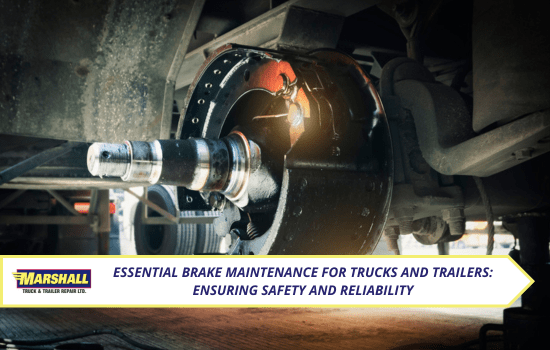Proper brake maintenance is essential for ensuring the safety, reliability, and efficiency of commercial trucks and trailers. By adhering to regular inspection, adjustment, lubrication, and replacement schedules, operators can mitigate risks associated with brake failure and optimize performance.
Reliability on the Road: Critical Brake Maintenance for Trucks and Trailers
 Brakes are arguably the most critical safety component of any commercial truck and trailer. Proper brake maintenance not only ensures the safety of the driver and others on the road but also contributes to the overall reliability and efficiency of the vehicle. Here’s a comprehensive guide to essential brake maintenance practices that every truck driver and fleet manager should prioritize.
Brakes are arguably the most critical safety component of any commercial truck and trailer. Proper brake maintenance not only ensures the safety of the driver and others on the road but also contributes to the overall reliability and efficiency of the vehicle. Here’s a comprehensive guide to essential brake maintenance practices that every truck driver and fleet manager should prioritize.
#1 Regular Inspections
Regular inspections are the cornerstone of effective brake maintenance. Inspect brakes at predetermined intervals according to manufacturer recommendations and regulatory requirements. Pay attention to brake pads, rotors, drums, shoes, and hydraulic components for signs of wear, damage, or corrosion. Inspect brake lines and hoses for leaks, cracks, or abrasions that could compromise braking performance. We recommend incorporating daily inspections as they are beneficial.
#2 Brake Adjustment
Proper brake adjustment is crucial for optimal braking efficiency. Ensure that brakes are adjusted according to manufacturer specifications and regulatory standards. Over-adjusted brakes can lead to premature wear, while under-adjusted brakes can compromise stopping power.
#3 Brake Fluid Inspection and Replacement
Brake fluid plays a critical role in hydraulic braking systems by transmitting force from the brake pedal to the brakes themselves. Regularly inspect brake fluid levels and condition. Replace brake fluid at recommended intervals to maintain hydraulic system integrity and prevent brake failure.
#4 Lubrication of Brake Components
Proper lubrication of brake components is essential to prevent friction and ensure smooth operation. Apply appropriate lubricants to moving parts such as calliper slides, pins, and bushings. Use high-temperature grease to withstand the heat generated during braking. Lubricate slack adjusters and S-cam bushings to maintain proper movement and alignment, reducing wear and extending component life.
#5 Brake Drum and Rotor Maintenance
Brake drums and rotors endure significant stress and heat during braking. Inspect drums and rotors for signs of wear, scoring, or heat cracks. Replace worn or damaged drums and rotors promptly to maintain braking efficiency and prevent more extensive damage to brake components.
#6 Brake Pad and Shoe Replacement
Brake pads and shoes are subjected to friction and wear during braking. Monitor brake pad and shoe thickness regularly and replace them when they reach the minimum wear limits specified by the manufacturer. Use quality brake pads and shoes that are compatible with the vehicle's braking system to ensure reliable performance and longevity.
#7 Brake Testing and Performance Evaluation
Regularly test brake performance using appropriate methods such as brake stroke measurement, brake force balance testing, and brake fade assessment. Conduct brake tests under loaded and unloaded conditions to simulate real-world scenarios. Evaluate braking efficiency and responsiveness to identify potential issues early and take corrective action promptly.
